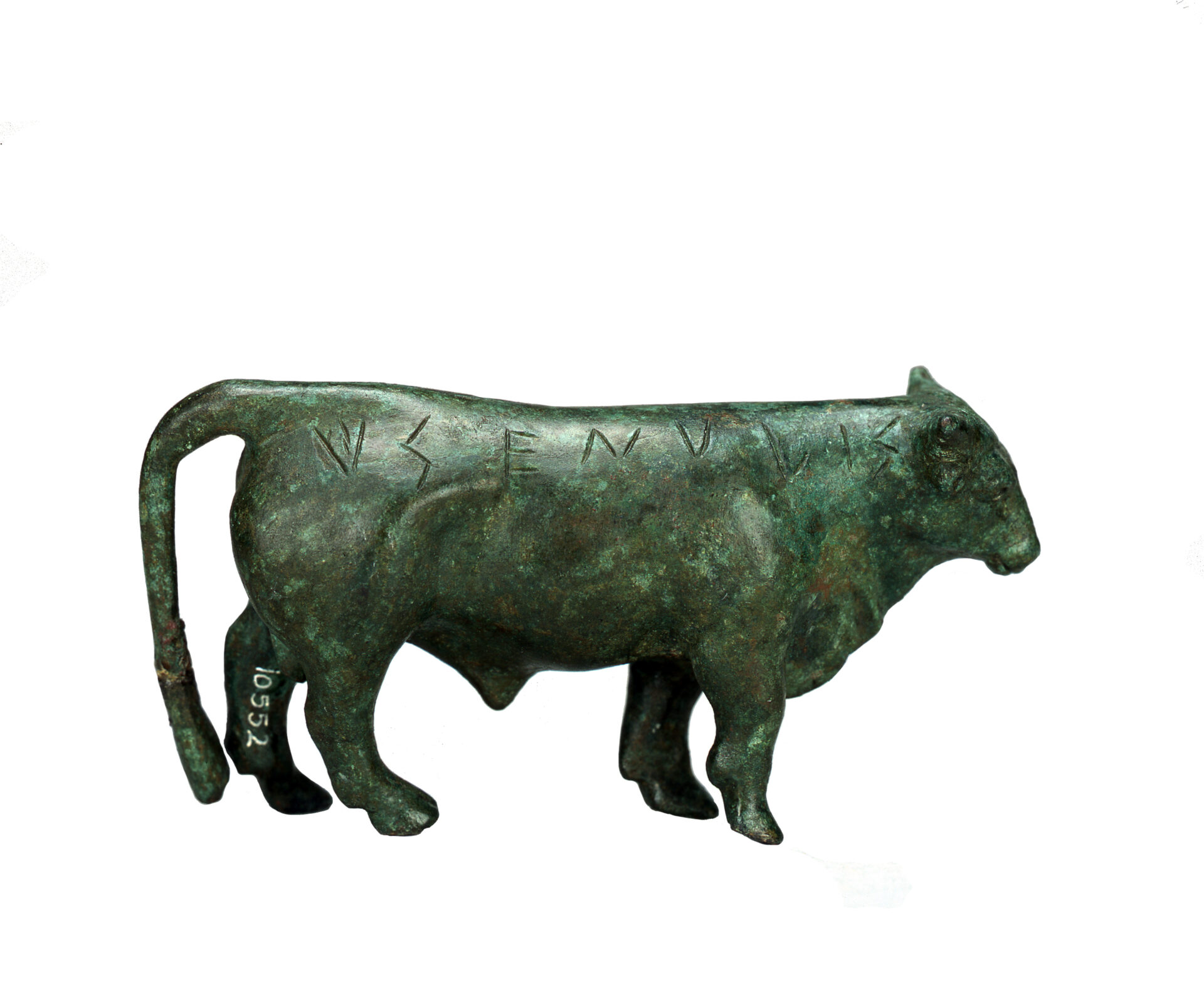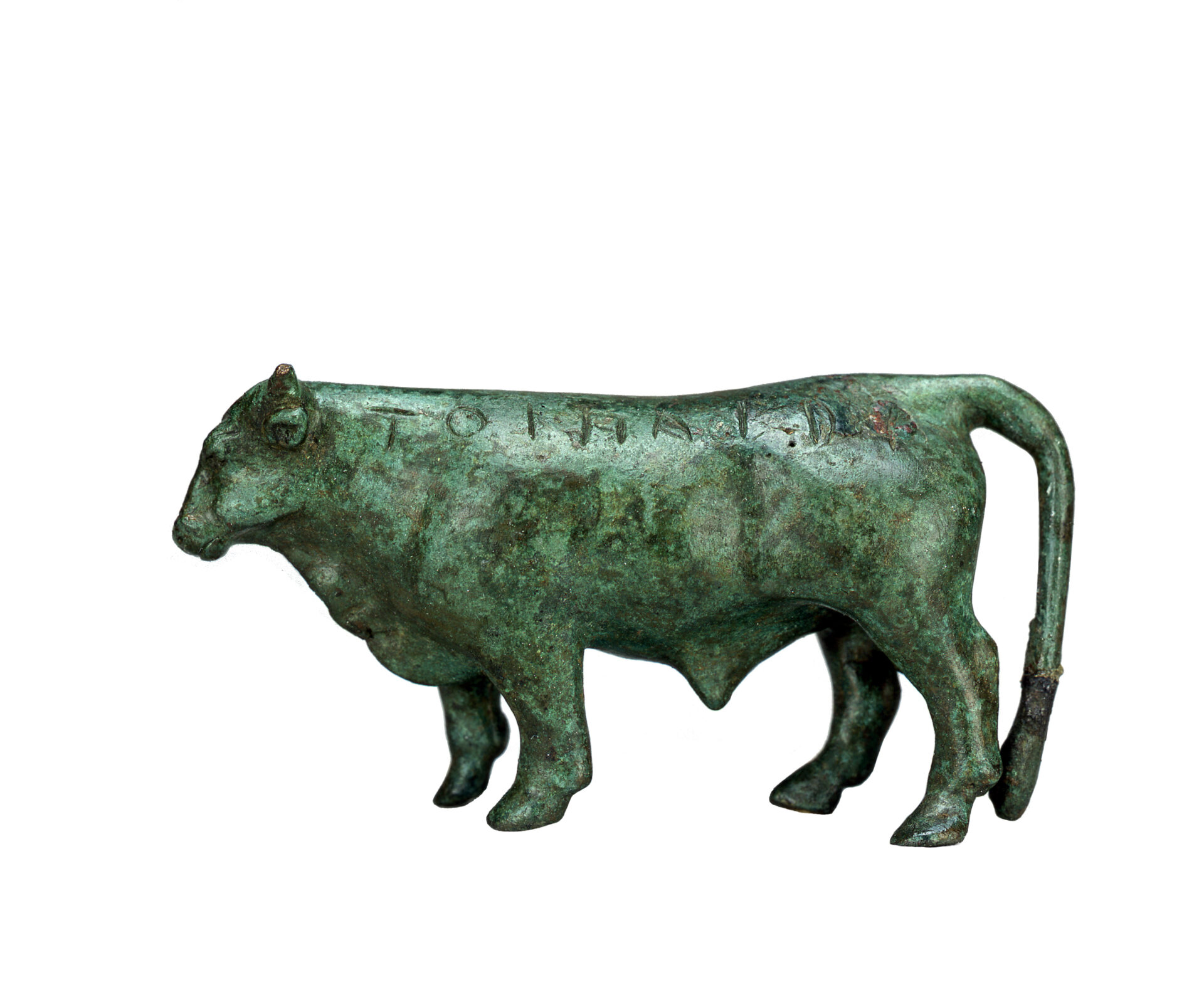Exhibit of the month
The divine Child from the Sanctuary of the Kabiroi in Thebes
Bronze bull figurine with inscriptions
National Archaeological Museum
Metalwork Collection, inv. no. X 10552
Provenance: Sanctuary of the Kabiroi in Thebes
Dimensions: Height 5.16 cm, L. 9.8 cm.
Date: Approx. 550-500 BC
Display Location: Room 36, Case 12, No. 19.
On the bull’s figurine, the heavy back and anatomical features of the animal are rendered with plasticity. On the right side of the body is engraved, in Boeotian alphabet, the feminine name (XSENYLIS). On the left side of the body, another engraved inscription states (TOIΠAIΔI). According to the inscriptions, Chsenylis dedicated the figurine to the Child (Pais), while surviving traces of letters below the inscription state that initially the robust bull was assigned to Kabiros (KAVIRO) but at some point the assignment was changed in favor of the Child.
The robust bull forms the dominant category of the numerous bronze and lead figurines found in the Sanctuary of the Kabiroi at Thebes[1], dating from the 10th up to the late 6th c. BC. Such figurines were votive offerings of the worshippers and many of them bear inscriptions engraved on their bodies, which state that sometimes they were offered to Kaviros and others to the Child or to both; often, the name of the male dedicator is mentioned (female dedications like that of the bull X 10552 are rare).
But who were the recipients of the metal votive bulls?
Demons or deities of Eastern origin (of Phoenician, Asia Minor or Semitic origin) with a name that semantically denotes the “powerful” or “great” gods, the Kabiroi housed their worship in the sanctuaries of Samothrace, Lemnos and Thebes, but also in other less known ones. Their worship[2] always included mystic rituals, which must have had the primary purpose of the euphoria of the fruits, the prosperity of the harvest, the enhancement of all-round fertility and eugenics. The initiates drew power by participating in them. In the Theban Kabirion[3], we know that Kabiros and the divine Child were worshipped, both from the various votive offerings that mention the two deities and from the iconography of the Kabirian ritual vessels that appears at the end of the 5th c. BC.
A skyphos fragment of the late 5th c. BC, exhibited in the National Archaeological Museum, Athens (EAM A 10426), depicts and names the mature/youthful nature of the divine diptych of the local cult: Kabiros in the form of a bearded and ivy-wreathed god reclining with a kantharus in his hand like another Dionysus, and godlike Pais drawing wine for his Father with an oinochoe from a krater. The scene, valuable for the understanding of the relationship between Kabiros and the Child, has been associated with the practice followed at banquets by young people to serve wine to adults and it has been argued that the image of the Child who serves Kabiros probably reflects the image of the children who came for initiation to the sanctuary.
The rich finds from the excavations at the Sanctuary have led to the interpretative view that in the Theban Kabirion, rites of passage took place, i.e. rituals that marked the passage of boys from childhood to adolescence and from that to adult life. Thus, in addition to the bull-shaped figurines offered to Kabiros and the Child, another category of offerings to the divine Child is of particular interest: rattles, swivels (spindles) and astragals (sheep’s feet knuckles), simple toys that is, or their models made of clay, bronze or lead, dating to their majority to the 5th and up to the late 4th c. BC. These are votive offerings, which could be associated with the rites of passage, as we know that during their adulthood, young people dedicated to the sanctuaries personal objects associated with their earlier childhood, especially their toys.
Pais, the divine son with a youthful nature, accepts the initiation of mortals and takes under his protection the passage of children into adolescence and from there into adulthood. And passing from the divine to the worldly level, the youth is trained, completed in body and soul, transformed into a mature citizen and soldier of war (hoplite) who carries his weapons and defends his city.
[1] The location of the Theban Kabirion is mentioned by Pausanias (IX, 25, 5). The remains of the Sanctuary are located approximately eight kilometers west of Thebes. In ancient times, the Sanctuary was not visible from afar, because its view was lost in a natural depression between sandy mounds. The movable finds are divided today between the National Archaeological Museum and the Museum of Thebes.
[2] In Samothrace, the Kabiroi – “Great Gods” protected sea voyages and sailors. In Lemnos, sons of the local goddess Kabiros and Hephaestus, they were metallurgists like their father, god of fire and metals, but also patrons of navigation. Gradually, the mystical cult of the Kabiroi spread in many places in antiquity.
[3] The testimony of Pausanias (IX, 25, 6) is characteristic: “I must ask the curious to forgive me if I keep silence as to who the Kabiroi are, and what is the nature of the ritual performed in honor of them and of the Mother.”[3] But the “Kabirian Demeter” also played an important role as the presenter of the secret ceremonies. Pausanias (IX, 25,6-7) mentions that Demeter entrusted a secret legacy to Prometheus and his son Aetnaeus in the city of the inhabitants of Kabiria near Thebes and that the secret rites were a gift from Demeter to the Kabiria residents.
Also, regarding the sanctity of the space, Pausanias quotes (IX, 25, 8-10): ” The wrath of the Kabiroi no man may placate, as has been proved on many occasions...Again, when Alexander after his victory wasted with fire all the Thebaid, including Thebes itself, some men from Macedonia entered the sanctuary of the Kaeiroi, as it was in enemy territory, and were destroyed by thunder and lightning from heaven. So sacred this sanctuary has been from the beginning”.
Sapfo Athanasopoulou
Bibliography
For the bull figurine X 10552 see:
B. Schmaltz, Metallfiguren aus dem Kabirenheiligtum bei Theben. Die Statuetten aus Bronze und Blei, Berlin, 1980, 81-82, no. 333 (group 27), plate 18.
Ant. Nikolau, Y. Tzedakis (eds), Bulls: Image and Cult in the Ancient Mediterranean, Catalogue of the exhibition, Museu d’ Història de la Ciutat de Barcelona, 14.11.02-6.03.2003, Hellenic Ministry of Culture, 187, no .108 (R. Proskynitopoulou).
Inscriptiones Graecae VII, 3579A.B (Boeotia, Thebae).
For the Theban Kabirion (topography and history of architectural phases):
W. Heyder and Al., Mallwitz, Die Bauten im Kabiren-heiligtum bei Theben. Band II, Berlin 1978.
Nick. D. Papachatzi, Παυσανίου Ελλάδος Περιηγήσεις, Βοιωτία, IX, 25, 5-10, published by Athens Publishing House 1981.
On the metal animal figurines, the various categories of offerings, the cultic practices, the rites of passage and the use of the Kabirian ritual vessels, see:
Chr. Avronidaki, Ο ζωγράφος του Άργου. Συμβολή στην έρευνα της βοιωτικής ερυθρόμορφης κεραμικής στο β΄μισό του 5ου αιώνα π.Χ., Athens YPPO-TAPA 2007, 98-100, 101 n. 553,554, 102-114.
K.-P. Bilias, Hiaros Kabiro. Die beschriften Stiervotive aus Metall im Kabirion von Theben. Masters course in Classical Archäologie, Freie Universität Berlin, 2022.
M. Doumas, ”The Sanctuary of the Cabeiri” in Ant. Nikolau, Y. Tzedakis (eds), Bulls: Image and Cult in the Ancient Mediterranean, Catalog of the exhibition, Museu d’ Història de la Ciutat de Barcelona, 14.11.02-6.03.2003, Hellenic Ministry of Culture, 138-141 .
M. Doumas, Rites d’initiation au Cabirion de Thèbes, Επετηρίς της Εταιρείας Βοιωτικών Μελετών. Γ’ α΄, Athens 2000, 274-389.
A. Lebessi, Τα μετάλλινα ζώδια του Θηβαϊκού Καβιρίου, ΑΕ 1992, 1-19.
A. Schachter, The Theban Kabiroi, in Michael B. Cosmopoulos (ed.) Greek Mysteries: The Archeology and Ritual of Ancient Greek Secret Cults, London 2003, 114-142.




